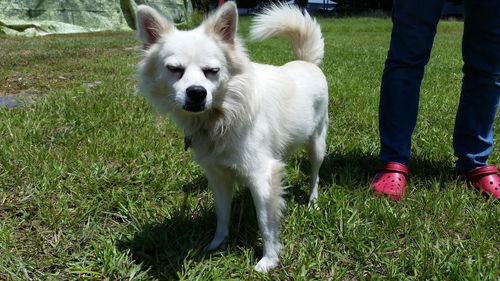Welcome to Pet Rescue By Judy!
401 South Laurel Avenue
Sanford, FL 32771
(407) 302-4497
info@petrescuebyjudy.com
Leroy "The Lap Dog"'s Web Page

| My Rescue |
| Login to Remember your Favorite Animals and Breeds! |
Name: Leroy "The Lap Dog"
Status: Adopted!
Adoption Fee: 250.00
Species: Dog
Breed: American Eskimo Dog / Spitz / Mixed
Learn more about the American Eskimo Dog.Sex: Male (neutered)
Current Size: 15 Pounds
Potential Size: 15 Pounds
General Potential Size: Small
Current Age: 12 Years (best estimate)
Activity Level: Moderately Active
Indoor or Outdoor: Indoor Only
Good with Dogs: Yes
Good with Kids: Yes
Microchipped: Yes
Description:
Leroy "The Lap Dog" is so beautiful...He came to us from another high kill shelter. We hope to find him the forever home that he deserves. He is a little timid right now but once in a home he will be fine. He loves to sit and be petted and play. Leroy is heartworm positive but that should not prevent him from living a full and active life. We use the slow kill method and literature will be provided at the time of adoption/fostering regarding this method. It has been proven very effective. We will also supply you with 6 months of heartguard pills.
According to www.dogbreedinfo.com, the American Eskimo is one of the Spitz families of Nordic breeds. They are closely related to the white German Spitz. German Spitz were eventually brought to America, where the name changed to American Eskimo Dog, due to the widespread anti-German feelings during World War I. Today they are known as a separate breed, but are closely related to the German Spitz. Samoyed and White Keeshond are also possibly related to the America Eskimo Dog. Evidence suggests that "White Spitz" dogs were first brought to the United States by German settlers. A couple named Hall, in 1913, were the first to register the breed with the UKC. Their kennel name was "American Eskimo" which became the name of the breed. The American Eskimo was spread throughout the United States by the Barnum and Bailey Circus. Stout's Pal Pierre was the first dog ever to walk a tight rope. The American Eskimo is a charming, affectionate and loving dog. Hardy and playful, they are excellent with children. Highly intelligent and willing to please. Alert and easy to train, the American Eskimo often ranks among the top scorers in obedience trials. Some individuals have a willful streak, but most like to work. Dogs whose ancestry displays nervousness, hyperactivity or viciousness should not be bred. They are naturally wary of strangers, but once introduced, they become instant friends. Some have been known to not let a stranger enter the home until the owner says it is okay. Eskimos need to be part of the family and engage in nuisance activities when isolated. Handle them gently, but firmly. This breed needs attention and loves to bark. Eskies should be thoroughly socialized when young to avoid potential aggression-related accidents. They have a life-expectancy of 15 years or more.
Leroy "The Lap Dog" is so beautiful...He came to us from another high kill shelter. We hope to find him the forever home that he deserves. He is a little timid right now but once in a home he will be fine. He loves to sit and be petted and play. Leroy is heartworm positive but that should not prevent him from living a full and active life. We use the slow kill method and literature will be provided at the time of adoption/fostering regarding this method. It has been proven very effective. We will also supply you with 6 months of heartguard pills.
According to www.dogbreedinfo.com, the American Eskimo is one of the Spitz families of Nordic breeds. They are closely related to the white German Spitz. German Spitz were eventually brought to America, where the name changed to American Eskimo Dog, due to the widespread anti-German feelings during World War I. Today they are known as a separate breed, but are closely related to the German Spitz. Samoyed and White Keeshond are also possibly related to the America Eskimo Dog. Evidence suggests that "White Spitz" dogs were first brought to the United States by German settlers. A couple named Hall, in 1913, were the first to register the breed with the UKC. Their kennel name was "American Eskimo" which became the name of the breed. The American Eskimo was spread throughout the United States by the Barnum and Bailey Circus. Stout's Pal Pierre was the first dog ever to walk a tight rope. The American Eskimo is a charming, affectionate and loving dog. Hardy and playful, they are excellent with children. Highly intelligent and willing to please. Alert and easy to train, the American Eskimo often ranks among the top scorers in obedience trials. Some individuals have a willful streak, but most like to work. Dogs whose ancestry displays nervousness, hyperactivity or viciousness should not be bred. They are naturally wary of strangers, but once introduced, they become instant friends. Some have been known to not let a stranger enter the home until the owner says it is okay. Eskimos need to be part of the family and engage in nuisance activities when isolated. Handle them gently, but firmly. This breed needs attention and loves to bark. Eskies should be thoroughly socialized when young to avoid potential aggression-related accidents. They have a life-expectancy of 15 years or more.
Other Pictures of Leroy "The Lap Dog" (click to see larger version):
 246.9k |
Copyright © Pet Rescue by Judy





